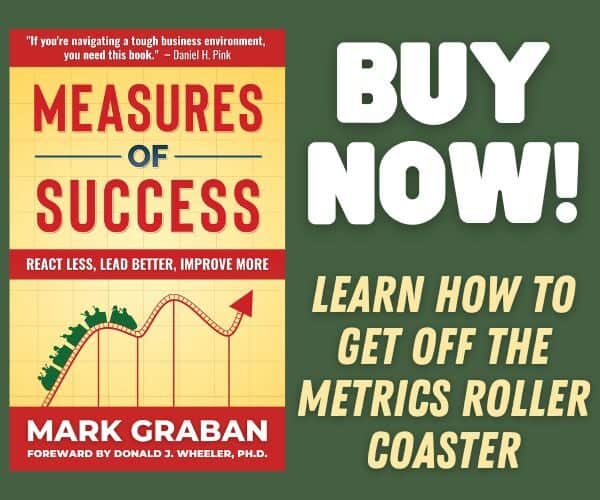A while back, I uploaded the entire PDF of my 2018 book, Measures of Success: React Less, Lead Better, Improve More, into the premium version of ChatGPT.
As an author and publisher, it's a really useful tool for generating marketing content — although maybe it's a mistake to upload my content that way. I'm sure a PDF of the book was already on the internet to be potentially scanned by ChatGPT. Please leave a comment if you think I made a big mistake there.
One use is what I'm sharing here: Asking ChatGPT to provide its summary of the book and each chapter. It did a really nice job.
Hear Mark read this post — subscribe to Lean Blog Audio
Measures of Success by Mark Graban is organized into key chapters and appendices that collectively aim to improve how organizations understand and utilize metrics for better management and decision-making. Here's a summary of the main points from each chapter:
1) Improving the Way We Improve: This chapter sets the stage by challenging conventional wisdom around managing metrics. Graban uses personal health metrics (like weight and cholesterol levels) as analogies for organizational metrics, emphasizing the importance of managing the system behind the metrics rather than the numbers themselves. He introduces the idea that reacting to every fluctuation in data can be counterproductive, laying the groundwork for a more thoughtful approach to improvement.
2) Using Process Behavior Charts for Metrics: Here, readers are introduced to the core tool of the book: Process Behavior Charts (PBCs). Graban explains how these charts can help distinguish between normal data variability and significant changes worth acting upon. This chapter is crucial for understanding how to apply the book's concepts to real-world metrics, making it a compelling reason for managers and leaders to dive deeper into the methodology.
3) Action Metrics, Not Overreaction Metrics: The focus is on choosing metrics that drive meaningful action without overreacting to normal variation. Graban argues that understanding the difference between common cause variation (inherent in the system) and special cause variation (indicating a real change) is key to effective management. This distinction helps organizations focus on systemic improvements rather than wasting resources on normal fluctuations.
4) Linking Charts to Improvement: This chapter demonstrates how to use PBCs as a foundation for systematic improvement efforts. Graban provides strategies for linking metrics to process improvements, ensuring that efforts are focused on making meaningful, data-driven changes. The emphasis is on leading with insight rather than reacting to the latest numbers, appealing to leaders looking for a sustainable path to excellence.
5) Learning From “The Red Bead Game”: Through the Red Bead Game, Graban illustrates the pitfalls of common management practices when interpreting performance data. The game highlights how misunderstanding data variability can lead to unfair judgments and ineffective management actions. This chapter is particularly engaging for its interactive learning approach, showing rather than just telling the principles of proper metric interpretation.
6) Looking Beyond the Headlines: Applying his principles to the interpretation of news and public data, Graban teaches readers to look deeper than the surface-level analysis often found in media. This chapter resonates with anyone interested in understanding how to critically assess information in a data-rich world, making it relevant beyond just organizational metrics.
7) Linear Trend Lines and Other Cautionary Tales: By critiquing common but flawed methods of data analysis, such as relying on linear trend lines, Graban steers readers towards more reliable analysis techniques. This chapter warns against oversimplification of data interpretation, advocating for a nuanced approach that recognizes the complexity of real-world processes.
8) Workplace Cases and Examples: Real-world applications of PBCs across various industries are showcased, illustrating the broad applicability of Graban's methods. This chapter makes the case for the versatility of PBCs, providing readers with concrete examples of how these concepts can be applied in their own workplaces.
9) Getting Started with Process Behavior Charts: Offering practical advice for implementing PBCs, this chapter serves as a guide for readers eager to put theory into practice. Graban outlines steps for creating and using PBCs, making the methodology accessible to those new to the concept.
The appendices provide detailed instructions on creating Process Behavior Charts, a summary of key points throughout the book, and additional resources for further learning. This structure ensures readers not only understand the theoretical underpinnings of effective metric management but also how to apply these concepts in practice for tangible improvements.
More Posts About the Red Bead Game / Experiment:
Posts About Applying Process Behavior Charts to the News:
Please scroll down (or click) to post a comment. Connect with me on LinkedIn.
Let’s work together to build a culture of continuous improvement and psychological safety. If you're a leader looking to create lasting change—not just projects—I help organizations:
- Engage people at all levels in sustainable improvement
- Shift from fear of mistakes to learning from them
- Apply Lean thinking in practical, people-centered ways
Interested in coaching or a keynote talk? Let’s start a conversation.









![When Was the Last Time a Leader Around You Admitted They Were Wrong? [Poll]](https://www.leanblog.org/wp-content/uploads/2025/07/Lean-Blog-Post-Cover-Image-2025-07-01T212509.843-100x75.jpg)
